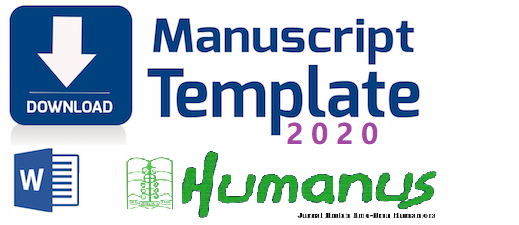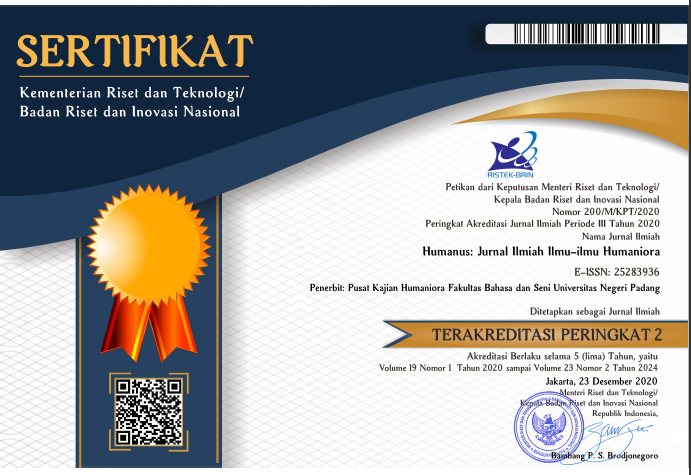Cooperative Principle and Politeness in Children's Conversation in Dharma Wanita Kindergarten School Environment, Bengkulu Province)
 ),
), (1) Universitas Bengkulu
 Corresponding Author
Corresponding Author
Copyright (c) 2022 Humanus
DOI : https://doi.org/10.24036/humanus.v21i1.115831
Full Text:
 Language : en
Language : en
Abstract
Language is a species-specific human capacity. Language is acquired gradually and simultaneously from birth. The purpose of this study was to find out a comprehensive description of forms and factors that influence the expression of acceptance and rejection of children's conversations in Dharma Wanita Kindergarten school, Bengkulu Province. A descriptive qualitative approach and ethnographic design were used in this study. The subjects of this study were children in the Dharma Wanita Kindergarten, Bengkulu Province. The researchers themselves are the key instrument. Data analysis shows that children in Dharma Wanita Kindergarten school can express personal attitudes in communicating. However, they have not fully applied the communicative principles (cooperative and politeness principle) in conversation, and any external factors influence their conversation.
Keywords
References
BAPPENAS. (2015). Rencana Jangka Menengah Nasional 2015-2019 Agenda Pembangunan Bidang (The National Development Plan 2015-2019 Sectoral Development Agenda). Jakarta: Kementerian PPN/BAPPENAS.
Chomsky, N. (2006). Language and mind (3rd ed). Cambridge ; New York: Cambridge University Press.
Coulthard, M., & Condlin, C. N. (2014). An introduction to discourse analysis. Routledge.
Dardjowidjojo, S. (2003). Psikolinguistik: Pengantar pemahaman bahasa manusia. Yayasan Pustaka Obor Indonesia.
Duranti, A. (2009). Linguistic anthropology: A reader. John Wiley & Sons.
Ellis, R. (2015). Understanding second language acquisition 2nd Edition-Oxford applied linguistics. Oxford university press.
Graves, K. (2000). Designing Language Courses:A Guidefor Teachers. Boston: Heinle & Heinle Publisher.
Gumono, G. (2011). PENGARUH STIMULUS TERHADAP PEMEROLEHAN BAHASA. Jurnal Bahasa, Sastra, dan Budaya, 1(1), 1–13.
Halliday, M. A. K., & Webster, J. J. (2016). Aspects of Language and Learning (1st ed. 2016). Berlin, Heidelberg: Springer Berlin Heidelberg : Imprint: Springer. https://doi.org/10.1007/978-3-662-47821-9
Hanna, P., & Harrison, B. (2004). Word and world: Practice and the foundations of language. Cambridge ; New York: Cambridge University Press.
Hoey, M., Mahlberg, M., Stubbs, M., & Teubert, W. (2007). Text , Discourse and Corpora Theory and Analysis. London: Continuum.
Jassin, A. (2008). Arah kajian bahasa: Kaitannya dengan perkembangan iptek dan sosial-budaya. File://D: van Dijk/Arah Kajian Bahasa,(Online),((http://www. com. diakses 28 ….
Kemendikbud. (2016). Rencana strategis terpadu pendidikan dan kebudayaan 2015—2019 | Perpustakaan Kementerian Pendidikan dan Kebudayaan. Kementerian Pendidikan dan Kebudayaan. Diambil dari //pustaka.kemdikbud.go.id%2Flibdikbud%2F%2Findex.php%3Fp%3Dshow_detail%26id%3D38212
KEMENDIKBUDRISTEKDIKTI. (2020). Rencana Strategis Direktorat Pendidikan Anak Usia Dini 2020-2024. Jakarta: Kementerian Pendidikan dan Kebudayaan.
Leech, G. N. (1983). Principles of Pragmatics. New York: Longman Group Ltd.
Lenneberg, E. H. (1967). The Biological Foundations of Language. Hospital Practice, 2(12), 59–67. https://doi.org/10.1080/21548331.1967.11707799
Mussen, P. H., & Conger, J. J. (1956). Child development and personality.
Ninio, A., & Snow, C. E. (2018). Pragmatic development. Routledge.
Piaget, J. (2011). The language and thought of the child. Read Books Ltd.
Romaine, S. (1984). The language of children and adolescents. Basil Blackwell.
Samarin, W. J. (1967). Field linguistics: A guide to linguistic field work. Holt, Rinehart and Winston.
Stubbs, M. (1983). DIscourse Analysis The Sociolinguistic Analysis of Natural Language. Chicago: The University of Chicago Press.
Sudaryanto. (1988). Metode linguistik. Yogyakarta: Gadjah Mada University Press.
 Article Metrics
Article Metrics
 Abstract Views : 387 times
Abstract Views : 387 times
 PDF Downloaded : 62 times
PDF Downloaded : 62 times
Refbacks
- There are currently no refbacks.
Copyright (c) 2022 Humanus

This work is licensed under a Creative Commons Attribution-NonCommercial 4.0 International License.










